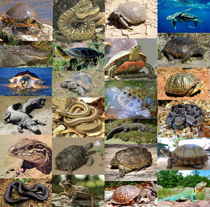
Massachusetts Symbols
Massachusetts State Reptile
Eastern garter snake

Adopted on January 3, 2007
Taking its place with the Roxbury puddingstone (the state rock), the navy bean (the state bean) and the tabby cat (hint - it isn't the state dog), the Eastern garter snake has slithered into the history books as Massachusetts' official state reptile.
As one of his final acts before leaving his distinguished office, Gov. W. Mitt Romney signed the order on Wednesday honoring the commonwealth's most common snake.
The process began three years ago when two Kingston elementary school students promoted the idea to their local representative, after finding that, egad, the Bay State (the official state nickname) lacked a state reptile.
The green-and-yellow snake, which grows to about 2 feet in length, must have had friends in high places, given the strong competition. There are 14 varieties of snakes native to Massachusetts, 15 turtles (including some rarely seen sea turtles), as well as something called the five-lined skink - all reptiles.
The garter snake now joins the illustrious company of other state representatives in the animal, plant and rock kingdoms, not to mention the comfort food kingdom (our official state cookie is the chocolate chip and the official dessert is the Boston cream pie).
Massachusetts State Reptile: Garter Snake

The garter snake (Thamnophis)
comprises a genus of mildly venomous colubrid snakes common across North America, ranging from the Alaskan Panhandle to Central America. It is the
single most widely distributed genus of reptiles in North America.[citation needed] The garter snake is also the Massachusetts state reptile.
With no real consensus on the classification of species of Thamnophis, disagreement among taxonomists and sources, such as field guides, over whether
two types of snakes are separate species or subspecies of the same species is common.[citation needed] Garter snakes are also closely related to the
snakes of the genus Nerodia with some species having been moved back and forth between genera.
The garter snake is a relatively harmless, mildly poisonous snake commonly found across North America. Its bite and saliva can kill small animals, but usually causes no more than minor irritation in humans. It's extremely adaptable and can live in a wide variety of habitats, though it generally likes to be near freshwater. It relies on heat from the sun and other garter snakes to maintain its body temperature. The garter snake was designated the official reptile of Massachusetts on January 3, 2007.
Description

Adult Common Gartersnakes range from 16 to 42 inches in length. This snake has two color variations in Montana. The first has three yellow longitudinal stripes (one dorsal and two lateral) and a black stripe broken by red spots between the yellow stripes. The lateral stripes are located on the second and third scale rows above the belly scales. The second color variation has the same striping pattern but lacks the red dots. In both variations, the background color between stripes is black to dark olive. The belly color ranges from yellow to bluish, and some individuals of the red-sided color variation have small black spots on the edge of the belly scales. The dorsal scales are keeled, and normally there are seven scales on the upper lip. Coloration varies geographically. There are 19 dorsal scale rows at mid-body and lateral stripes on the 2nd and 3rd scale rows (also on row 4 in subspecies annectens). There are 7 upper labials, 1 preocular, and 3 postoculars. The scales are keeled, and the anal undivided. The total length of adults is usually 41 to 66 centimeters (up to 131 centimeters). Common Gartersnakes are around 12 to 23 centimeters at birth (Conant and Collins 1991, Smith and Brodie 1982).
Habitat
Garter snakes live in woodlands, meadows, and grassy knolls and like to be near water. They sometimes reside in suburban areas with sufficient moist cover from logs or debris.
Habits
Garter snakes are generally active during the day. Some are excellent swimmers. When threatened, garter snakes give off a bad-smelling musk. Because
of their small size, garter snakes have many predators, including birds, bears and raccoons.
Cold-climate garter snakes hibernate during the winter. They hibernate in dens in large groups, with hundreds of garter snakes sometimes found together.
Garter snakes will travel up to 20 miles to a communal den for hibernation.
Diet
Garter snakes are small and will eat most anything they can overpower, including earthworms, slugs, crickets and other insects, frogs, fish, tadpoles, small birds, and small rodents. They kill their prey with their neurotoxic venom, which paralyzes it. They then swallow it whole.
Reproduction
When it is time to mate, female garter snakes give off pheromones to attract males. Dozens of males will come to one female, which is why homeowners
sometimes think garter snakes are overrunning their neighborhoods.
After mating, females store sperm in their bodies until they want to fertilize their eggs. They can store sperm for up to 5 years. Garter snakes give
birth to 20 to 40 live young at a time. The largest known litter of baby garter snakes had 98 babies. Parent snakes do not care for their young.
Massachusetts Law
The law designating the garter snake as the official Massachusetts state reptile is found in the General Laws of Massachusetts, Part 1, Title 1, Chapter 2, Section 57
PART I ADMINISTRATION OF THE GOVERNMENT
TITLE I JURISDICTION AND EMBLEMS OF THE COMMONWEALTH, THE GENERAL COURT, STATUTES AND PUBLIC DOCUMENTS
CHAPTER 2 ARMS, GREAT SEAL AND OTHER EMBLEMS OF THE COMMONWEALTH
Section 57 Reptile of commonwealth
Section 57. The garter snake shall be the official reptile of the commonwealth.
Taxonomic Hierarchy: Garter Snake
Kingdom: Animalia
Phylum: Vertebrates - Craniata
Class: Reptiles - Reptilia
Order: Order - Lizards / Snakes - Squamata
Family: Colubrid Snakes - Colubridae
Genus: Thamnophis
Species: Thamnophis sirtalis sirtalis - common eastern gartersnake







